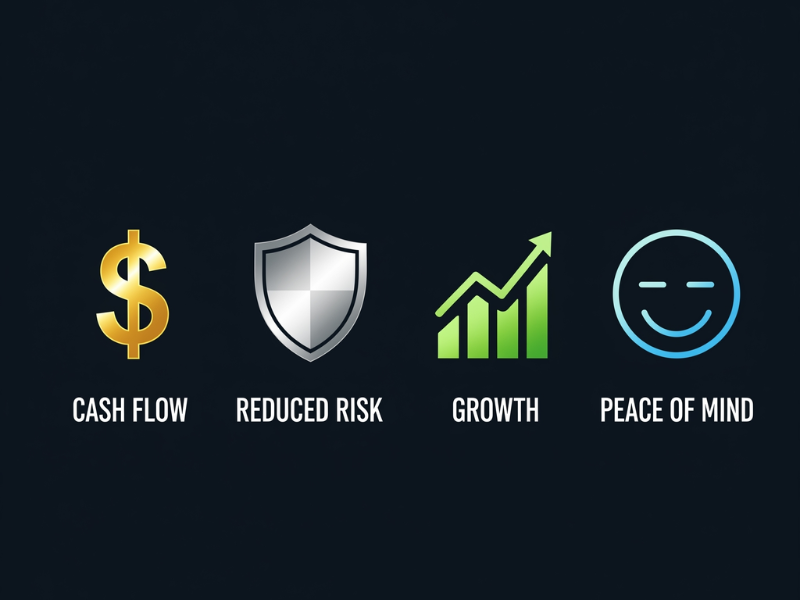Physical Address
304 North Cardinal St.
Dorchester Center, MA 02124
Physical Address
304 North Cardinal St.
Dorchester Center, MA 02124

Did you know that nearly 82% of businesses fail due to poor cash flow management? That stat alone shows why financial planning for business owners isn’t just a “nice-to-have”, it’s survival. Running a business is exciting, but without a clear financial roadmap, it’s easy to get blindsided by unexpected expenses or tax bills.
In this guide, we’ll break down exactly how business owners can build a strong financial foundation in 2025. From budgeting and forecasting to retirement planning and risk management, you’ll find strategies to keep your business thriving long term.

I once worked with a small café owner who thought financial planning was just for “big corporations.” She was great at making coffee, but not so great at tracking her expenses. Within a year, her profits vanished—she didn’t even realize her suppliers were raising prices slowly, and she was too busy to adjust her menu costs. By the time she caught on, she had burned through most of her savings. That’s what happens when financial planning gets pushed aside.
The truth is, without a clear plan, small issues snowball into financial disasters. A surprise tax bill, a slow sales month, or a broken piece of equipment can wipe out your cash reserves if you’re not prepared.
I can’t tell you how many business owners I’ve seen who live with constant anxiety because they don’t know where their money is going. They check their bank balance like it’s a crystal ball. The irony is, once they sit down and actually create a plan, that stress fades almost overnight. Knowing you’ve accounted for expenses, taxes, and growth gives you peace of mind. It’s like finally turning on the headlights while driving at night—you see where you’re headed.
Another friend of mine runs an online retail shop. When she started planning her finances, she realized she had enough cash flow to invest in digital ads. Within three months, her sales doubled. She told me, “If I hadn’t budgeted and tracked my numbers, I’d never have had the confidence to spend that money.”
Financial planning isn’t just about keeping the lights on, it’s about creating space for growth. Once you know your margins, expenses, and potential risks, you can make bold moves without feeling reckless.
The business world today is unpredictable, interest rates change, supply chains are unstable, and technology moves fast. Planning isn’t about being rigid; it’s about being ready. Think of financial planning as your safety net. It doesn’t mean you’ll avoid every challenge, but it does mean you’ll land on your feet when they come.
When I first started consulting, every business owner I spoke to had the same goal: “I just want to make more money.” Sounds good on paper, but it’s not really a goal, it’s a wish. I remember one client, a landscaper, who set that vague goal year after year. He worked harder, booked more clients, but never felt like he was getting ahead. Once we drilled down into specifics, like saving $50,000 for new equipment within 18 months—he finally had something he could measure and track.
That’s the magic of financial goals: clarity. When you put numbers, timelines, and purpose behind your plans, suddenly your business decisions stop feeling like guesses.
Here’s how I like to think of it: short-term goals are like the snacks you keep in your bag, quick boosts to keep you going. Long-term goals are the full meals, they take planning and patience.
Short-term business goals might look like:
Long-term goals might include:
Both are important. Short-term goals give you momentum, while long-term goals keep you moving in the right direction.
I resisted the SMART goal framework at first, it felt too “corporate.” But honestly, it works. Goals that are Specific, Measurable, Achievable, Relevant, and Time-bound force you to get real about what you’re chasing.
For example, instead of saying “I want better cash flow,” a SMART goal would be: “Increase monthly cash reserves by $2,000 within six months by reducing unnecessary expenses and negotiating supplier discounts.” See the difference? The second one tells you exactly what to do and how to measure progress.
Here’s a mistake I made early on: I tracked everything daily. Revenue, expenses, profit margins—you name it. It drove me nuts. What actually works better is checking in monthly or quarterly. That way you’re not obsessing over every blip, but you still catch problems before they spiral.
And don’t underestimate the power of visuals. I love using a simple chart that shows progress toward each goal. It’s motivating to see a line climb closer to your target instead of just staring at numbers on a spreadsheet.

I used to think budgeting meant cutting out everything fun, like trying to run a business on the financial equivalent of bread and water. But that mindset was wrong. A budget isn’t about restriction, it’s about control. One of my earliest mistakes as a business owner was not having a formal budget. I’d just pay bills as they came and hope there’d be enough left over. Spoiler: there usually wasn’t.
The first time I actually created a budget, I realized I was overspending hundreds of dollars a month on subscriptions and services I barely used. That small change gave me the breathing room to reinvest in marketing, which ended up bringing in more clients.
A good business budget doesn’t have to be complicated. Break it into three categories: fixed costs, variable costs, and growth.
Here’s what I learned the hard way, don’t forget to budget for growth. Too many owners treat growth as an afterthought, throwing money at it only if there’s something left at the end of the month. But if you want your business to thrive, investing in growth needs to be baked into the plan from the start.
Forecasting is where the magic happens. It’s not just about where your money is now, but where it’s going. Early on, I ignored forecasting because it felt like guessing. Then I had a season where sales dropped 40% in winter, and I wasn’t ready. My cash flow dried up, and I scrambled to keep things afloat.
If I had forecasted, I would have seen that slump coming and saved up during the busy season. Now, I always build a simple 12-month forecast. Even if it’s not perfect, it helps me spot patterns and prepare.
I’m not a spreadsheet wizard, so I lean on tools. QuickBooks, Xero, and even simple apps like Wave can make budgeting and forecasting way less painful. I also use a rolling forecast, basically updating the plan every month with new data. That way, I’m never blindsided.
And here’s my favorite trick: scenario planning. I build three forecasts, best case, worst case, and most likely. It’s like having a weather forecast for your finances. When things take a turn (and they always do), I already know how I’ll adjust.
When I first started consulting, I thought “cash flow” was just a fancy accounting term. I figured as long as my invoices were bigger than my expenses, I was fine. Wrong. One month, a big client delayed payment for 60 days. On paper, I looked profitable. In reality, I was scrambling to pay bills. I had to dip into my personal savings just to cover payroll. That was the wake-up call: profit doesn’t equal cash flow.
Cash flow is really just money coming in versus money going out. Sounds simple, but when you’ve got suppliers, employees, taxes, and loan payments, it adds up quick. I started tracking weekly instead of monthly, which felt like a chore at first, but it gave me a clear picture of what was actually happening. Even just listing every inflow and outflow in a spreadsheet showed me patterns I hadn’t noticed.
One big change? I spotted that clients were consistently paying late. So, I added small late fees and tightened payment terms. Guess what, most of them suddenly paid on time.
Think of cash flow like breathing, if it stops, so does your business. That’s why I’m a big believer in having a “business emergency fund.” I try to keep at least three months’ worth of expenses tucked away. It’s not glamorous, but it saved me during the pandemic slump.
Here’s the trick: start small. Even setting aside 2–5% of revenue each month builds a cushion over time. It’s like putting spare change in a jar, you don’t notice it at first, but one day you’ll be glad it’s there.
One lesson I learned the hard way was the importance of timing. You might have money “coming in,” but if it arrives after rent is due, you’re in trouble. That’s where managing working capital comes in, keeping enough short-term assets (like cash or receivables) to cover short-term obligations.
I’ve seen owners rely too heavily on credit cards to bridge the gap, which can spiral fast. A better move? Negotiate with suppliers for longer terms or offer discounts to clients who pay early. Sometimes cash flow isn’t about making more money, it’s about adjusting the timing.
I personally like using a simple cash flow dashboard, QuickBooks has one, but even Google Sheets works fine. The key is visibility. If you can see the problem coming a month in advance, you can fix it before it hits.
And here’s my golden rule: never assume tomorrow’s sales will cover today’s expenses. Always plan with the cash you already have.

I’ll never forget my second year in business. I thought I was doing great, steady clients, cash in the bank, and even a little extra to reinvest. Then tax season hit. I owed way more than I expected because I hadn’t set money aside properly. To make things worse, I had missed a filing deadline, so I got slapped with penalties. That sinking feeling of writing a huge check I wasn’t prepared for is something I never want to repeat, and it taught me a big lesson: taxes aren’t a once-a-year event, they’re year-round planning.
Every business owner needs to know their tax obligations early on. Are you paying income tax, self-employment tax, sales tax, or payroll tax? The answer depends on your structure, sole proprietorship, LLC, S-Corp, or something else. I used to gloss over this, but the truth is, not knowing is expensive. A simple sit-down with an accountant clarified what I owed and when, and suddenly tax season wasn’t this big scary mystery anymore.
Once I got serious about tax planning, I realized how much money I had been leaving on the table. For example, I hadn’t been tracking deductible expenses properly. Office supplies, mileage, software subscriptions, they all add up. Keeping good records turned into real savings.
Here’s one trick I swear by: open a separate savings account just for taxes. Every time money comes in, I transfer 20–30% into that account. It feels like paying myself first, but really, I’m paying the IRS first. When tax season comes, I’m not scrambling, it’s already there.
I used to see hiring an accountant as an unnecessary expense. But the first year I worked with one, she saved me more than her fee in deductions and strategy. She pointed out things I didn’t even know I could write off and showed me how to structure payments to avoid penalties. Now I see it as an investment.
Some mistakes I’ve seen (and made):
The IRS doesn’t care if you’re busy, you’re still responsible. Staying compliant not only saves money, it keeps you out of legal trouble.
With tax laws changing all the time, especially around deductions for remote work and digital tools, staying updated matters. What worked three years ago might not cut it now. That’s why I build tax planning into my overall financial strategy instead of treating it like a seasonal chore. It’s just part of running the business.
Back when I ran a small side business, I thought insurance was optional. I figured, “I’m too small to need it.” Then a client slipped in my office space and threatened legal action. My heart dropped. Luckily, nothing came of it, but I realized how vulnerable I was. If it had gone differently, one accident could have wiped me out. That was my wake-up call: protecting your business with the right insurance isn’t a luxury, it’s survival.
There isn’t just one kind of insurance for business owners. The basics usually include:
When I finally sat down with a broker, I realized my biggest risk wasn’t fire or theft, it was liability. If a client claimed I gave bad advice that cost them money, I could be on the hook. That shifted how I thought about coverage.
Insurance premiums can feel like throwing money away, especially when you don’t use them. I used to cut corners and buy the cheapest policy just to “check the box.” But I learned the hard way that the cheapest plan doesn’t always cover what you actually need. One owner I knew had property insurance that didn’t include flood damage. When his office flooded, he was on his own.
Now I look at insurance the same way I look at seatbelts, you hope you’ll never need it, but when you do, it’s worth every penny.
Insurance is just one piece of the puzzle. Risk management also means planning ahead to minimize problems in the first place. That might look like:
These days, risks aren’t just physical—they’re digital. Cyberattacks, phishing scams, and data breaches hit small businesses just as often as large ones. That’s why cyber insurance has become a serious consideration. Protecting customer data isn’t just good ethics, it’s the law in many industries.
For me, risk management shifted from “do I really need this?” to “what’s the cost if I don’t?” Once I thought of it that way, the decision was easy.

When I first started my business, retirement felt like something only corporate employees had to worry about. I thought, “I’ll sell my business one day, and that will fund everything.” The problem? That’s not a plan—it’s a gamble. If your business doesn’t sell for what you hope, or the market shifts, you’re left scrambling. I realized I needed to build my own retirement safety net outside of my business.
The good news is, business owners have several options that give both retirement security and tax advantages. Some of the most common include:
When I set up my Solo 401(k), I felt a huge sense of relief. It wasn’t just about saving money, it was about finally paying myself first instead of always reinvesting in the business.
Retirement isn’t just about money. It’s also about what happens to your business when you step away. I once worked with a client who ran a family-owned shop. He assumed his kids would take over, but none of them wanted to. The business ended up closing, and years of legacy were lost.
Succession planning forces you to ask tough questions:
Creating a succession plan early gives you flexibility. It allows you to train future leaders, make the business more appealing to buyers, or simply prepare for an eventual sale.
One thing I’ve learned is not to rely on a single exit strategy. Hoping your business will sell for millions is risky. Instead, diversify, save in retirement accounts, invest outside your business, and prepare your company so it’s attractive to future buyers.
By the time I hit my mid-40s, I stopped thinking of retirement as “the end” and started viewing it as freedom, the freedom to step away when I want, not when I’m forced to.
When I first tried to create a financial plan for my business, I searched everywhere for the “perfect template.” I wanted a checklist that would guarantee success. The truth? There isn’t one. Every business is different. What works for a tech startup might not work for a family-owned café. What matters most is building a plan that fits your goals, your lifestyle, and your vision for the future.
I’ve learned that financial planning is less about perfection and more about consistency. Even small, steady improvements like tracking cash flow more carefully or contributing regularly to retirement compound into huge benefits over time.
After years of trial and error, I started using a simple three-part framework that works for nearly every business owner I’ve worked with:
This framework reminds me that financial planning isn’t just about avoiding failure, it’s about setting myself up to actually enjoy the rewards of owning a business.
For a long time, I thought asking for financial advice meant I wasn’t capable enough. But once I worked with a financial planner who specialized in entrepreneurs, I realized how much time and stress I had been wasting trying to figure everything out alone. A good advisor doesn’t replace your decision-making; they give you better information so your decisions are stronger.
Even if you’re not ready for a full-time financial advisor, tools like accounting software, online financial calculators, and industry mentors can give you a huge edge.
If you’ve made it this far, you already know the basics of financial planning for business owners. The question is: what’s your next step? Maybe it’s setting up that emergency fund. Maybe it’s reviewing your insurance. Maybe it’s finally opening that retirement account you’ve been putting off.
Don’t wait for the “right time.” Start with one small action today. The earlier you put these pieces in place, the easier it becomes to grow your business with confidence and build the life you want outside of it.
Want to dive deeper into financial topics? Check out our other guides:
Financial planning for business owners is the process of managing your business finances to achieve goals, ensure stability, and prepare for growth. It includes budgeting, cash flow management, tax planning, risk management, retirement preparation, and succession planning. Essentially, it’s creating a roadmap that helps your business thrive now and in the future.
Many small businesses fail due to poor financial management or unexpected expenses. Financial planning helps owners track income and expenses, anticipate challenges, make informed investment decisions, and avoid cash flow crises. It also ensures you’re prepared for taxes, emergencies, and future growth opportunities.
Start by assessing your current financial situation, including income, expenses, debts, and assets. Set short-term and long-term financial goals, create a budget, forecast future cash flow, and plan for taxes. Incorporate risk management strategies and plan for retirement and business succession. Tools like QuickBooks, Xero, or spreadsheets can help you track and adjust your plan over time.
Ideally, you should review your financial plan quarterly. Cash flow, expenses, and business goals can change, so updating your plan ensures it remains relevant. Monthly monitoring of key metrics, like cash reserves and overdue invoices, also helps prevent surprises.
Cash flow management is tracking the money coming into and going out of your business. Even profitable businesses can fail if they run out of cash. Proper cash flow management ensures you can pay bills, invest in growth, and handle emergencies without financial strain.
While not mandatory, working with a financial advisor or accountant can save time, reduce errors, and help you identify tax deductions or growth opportunities you might miss. Advisors can provide tailored strategies based on your industry, business size, and long-term goals.
Set a realistic budget that separates fixed costs, variable costs, and growth investments. Forecast revenue, track performance, and reinvest profits strategically. Use scenario planning—best-case, worst-case, and expected scenarios—to make informed decisions without overspending.
Business owners can use retirement accounts like Solo 401(k)s, SEP IRAs, SIMPLE IRAs, or traditional/Roth IRAs. Contributing regularly, even while reinvesting in the business, ensures financial security later. Additionally, succession planning can provide an exit strategy to monetize your business when retiring.